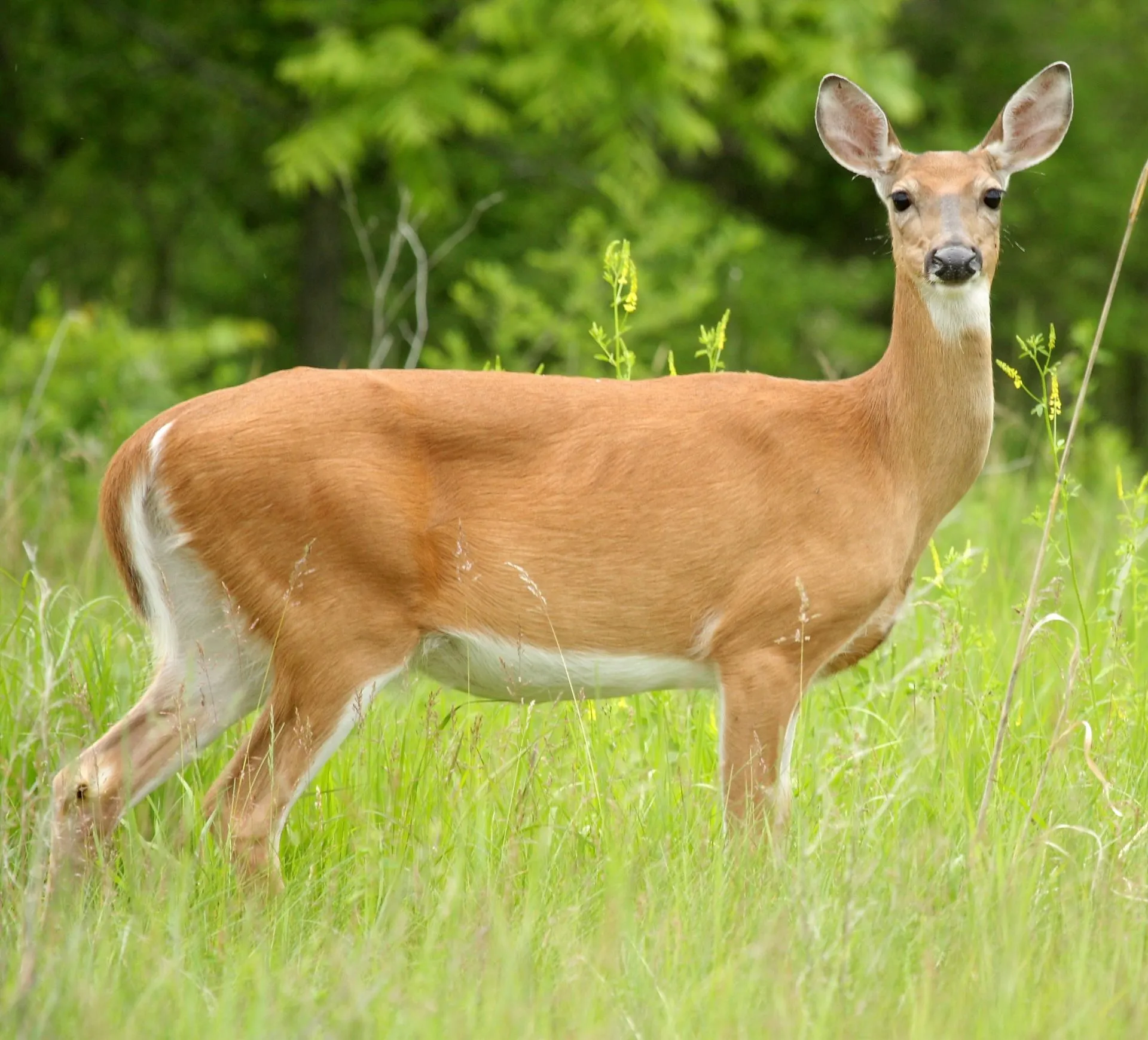Get ready to plunge into the secret world of white-tailed deer, where they’ll leap over any obstacle like it’s a joke! Watch their little ones vanish before your eyes with their sneaky camouflage. And hold on tight as they sniff out everything around them, like they have superpowers! Each encounter with these amazing animals is like opening a window to a whole new world. So, let’s jump in and discover the incredible powers of the white-tailed deer!
Fun Facts About White-Tailed Deer
White-tailed deer, those graceful creatures we often spot bounding through the woods, are full of surprises! Let’s dive into some fun facts about these fascinating animals:
Acrobatic Ability
Ever seen a deer clear a fence with ease? It’s no illusion! White-tailed deer are incredibly athletic. They can jump up to 10 feet in the air—that’s like jumping over a basketball hoop! And when they run, hold on tight—they can reach speeds of 30 mph, making them one of the fastest animals in North America.
A Different Worldview
Imagine a world painted in shades of blue and yellow. That’s what the world looks like to a white-tailed deer! Their eyes perceive color differently than ours, making it hard for them to see reds and oranges. So, that bright orange vest you wear during hunting season? They might not even notice it.
Antlers: A Male Distinction
You won’t see a female white-tailed deer sporting a majestic rack of antlers. Only the males grow these impressive bony structures, and they shed and regrow them every year. It’s all part of the competition for mates—the bigger and more impressive the antlers, the better the chances of attracting a female.
Creatures of the Twilight
White-tailed deer are most active in the soft light of dawn and dusk. It’s during these “twilight hours” that they venture out to find food and avoid running into predators. So, if you’re an early bird or a night owl, you just might catch a glimpse of these elusive creatures.
More Amazing Tidbits:
- America’s Favorite: They’re the most popular large game animal in the United States, with a population exceeding 30 million!
- Masters of Disguise: Their coats change color with the seasons—reddish-brown in summer for blending into leafy surroundings and gray-brown in winter to match the bare trees.
- Flashing a Warning: That bright white underside of their tail? It’s not just for decoration! When startled, they raise their tails like a warning flag to alert other deer in the area of danger.
What Makes Baby Deer So Adorable? – Discovering the Secrets of Fawn Camouflage
Ever strolled through the woods and wondered, “How could anything so tiny survive out here?” Well, those adorable fawns have a few tricks up their tiny hooves! It’s not just about being cute; it’s about outsmarting danger with some seriously impressive survival tactics.
A Coat of Many Spots: Blending Right In
Imagine a dappled forest floor, sunlight filtering through the leaves. Now picture a fawn, its reddish-brown coat sprinkled with white spots. Those spots aren’t just for looks! They act like camouflage, breaking up the fawn’s outline and making it blend seamlessly with the shadows and sunlight on the forest floor. It’s like a real-life game of hide and seek, and the fawn is a master!
The Art of Staying Still: Silence is Golden
Fawns take camouflage to another level by becoming masters of stillness. They’ll stay perfectly still for hours, instinctively knowing that movement attracts attention. And here’s the kicker: fawns also have very little scent, making them even harder for predators to sniff out. Talk about stealth mode!
Milk for Growth: Fueling Up for Adventure
Born with just four tiny teeth, fawns rely entirely on their mother’s milk for nourishment. They’re frequent diners, nursing up to five times a day! All that milk provides the energy and nutrients they need to grow stronger and eventually keep up with the herd.
Born Survivors: Tiny but Mighty
Fawns come into the world weighing a mere four to eight pounds, making them incredibly vulnerable. But their small size is actually an advantage! It allows them to hide in dense vegetation, making them harder for predators to spot. Plus, that reddish-brown coat, so perfect for camouflage, eventually fades as they grow older and less reliant on hiding.
Little Fawns, Big Impact: The Circle of Life
These adorable creatures play a vital role in the ecosystem. As they grow and thrive, they ensure the continuation of deer populations. Fawns are a symbol of new life and the delicate balance of nature. The next time you spot one, remember that their cuteness is just the tip of the iceberg – beneath it lies a world of incredible adaptations that help them survive and thrive in the wild.
Can White-Tailed Deer See Color? – Exploring the Sensory World of These Elusive Creatures
We’ve already talked about how amazing a white-tailed deer’s senses are, but let’s dive a little deeper into their vision. It’s a bit of a myth that they see the world in black and white, but they definitely don’t see colors the same way we do.
Think of it this way: deer see the world on a bit of a blue and yellow scale. Imagine those old sepia-toned photographs, but instead of everything being brownish, it’s mostly blues and yellows. That vibrant red hunting jacket you might wear? To a deer, it probably looks more like a muddy brown or grayish-yellow. This is because their eyes have fewer “cone cells” compared to humans. These cells help us differentiate between various colors, like a fiery sunset and a field of daffodils.
This doesn’t mean their vision is weak, though! It’s actually a brilliant adaptation to their environment. In the dim light of dawn and dusk, when deer are most active, being able to easily distinguish blues and yellows against a more muted background is incredibly useful. It helps them spot predators and find food more effectively.
So, what does this mean for us humans? Well, for hunters, it means choosing camouflage carefully. That bright orange vest might make you highly visible to other humans, but to a deer, it might blend right in with the fall foliage. And for those who simply enjoy observing these graceful creatures, it gives us a new appreciation for their unique way of experiencing the world.
Understanding how deer see color adds another layer to the story of how these animals thrive in their environment. It reminds us that what we perceive as humans is just one perspective, and that the natural world is full of wonders waiting to be discovered if we just take the time to look a little closer.
The Language of Whitetails – Deciphering the Grunts
We’ve already touched on how chatty white-tailed deer can be! Now, let’s delve deeper into their vocal repertoire, specifically those intriguing grunts that echo through the woods. Believe it or not, these aren’t just random noises – they’re a complex language with specific meanings that help deer navigate their world.
Think of it like this: deer can’t exactly send text messages or leave voicemails. So, they rely on different types of grunts to get their point across.
- Alarm Grunt: A short, sharp burst, like the deer equivalent of yelling “Watch out!” This warns others about potential danger. You might even see their tails fly up like a flag, adding a visual exclamation point to the message.
- Reassurance Grunt: A low rumble that’s all about keeping things calm. Imagine a mother deer using a soothing voice to tell her fawn everything is okay – that’s the vibe here. Even adult deer use it to comfort each other when they’re feeling a bit on edge.
- Social Grunts: These sounds are how deer size each other up and establish their place in the herd. Picture a big, strong buck letting out a deep, resonant grunt – that’s his way of saying, “I’m in charge here!”
- Communal Grunts: These are the deer version of a roll call, used to stay in touch, especially when they’re hidden in thick brush or it’s getting dark. Think of it as their way of saying, “Hey, where is everybody?”
By tuning into these different grunts, you can gain a whole new understanding of what those deer are thinking and doing. For hunters, it’s like getting a secret window into their world, giving you an edge in the field. For nature enthusiasts, knowing the language of deer adds a whole new layer of wonder to your observations. You’ll start to pick up on their subtle communications and appreciate just how intelligent and social these creatures truly are.
There are many things you might not know about deer. For fun facts about deer, click on this link to learn more about this amazing animal. Also, if you are a hunter then you might be interested to know some facts about hunting deer.












